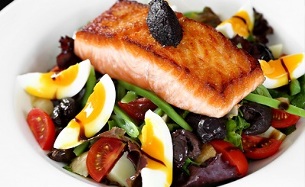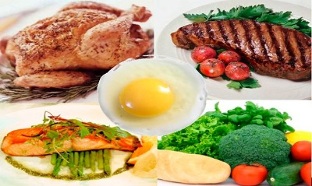How many times have you had to re-read many very effective diets that help rid people of subcutaneous fat? Do you know why there are more than 10, 000 opportunities in the world for various activities to lose weight? It's simple: because 90% of them are inefficient. A protein diet for weight loss is a good option, but it can also be ineffective if misused. How to use protein to lose weight without harming health with maximum results?
How to lose weight during a protein diet?
To get rid of subcutaneous fat, you need to know your body's physiological needs, understand when to eat carbohydrates and when to eat protein, and be able to listen to your body giving an unlimited number of prompts if we are malnourished.
Of course, most of you already know that by limiting your intake of sweet and complex carbohydrates, you can achieve significant weight loss, the exact number depends on the percentage of fat in your human body. It can be called a low carb diet, which is a very effective way to get rid of fat. The calorie deficit that results from reducing carbohydrates is completely supplemented with fat. Therefore, people lose weight by limiting the consumption of carbohydrates.
What happens if we completely eliminate carbohydrates from our diet?
Will we get a better way to lose weight? Our answer: naturally, yes. This diet was especially popular in the golden age of bodybuilding and was widely popularized by Vincent Gironde. You just have to look at his photo and it will immediately become clear why he recommended it. This one of the best name, according to many nutritionists, for effective fat burning methods is the protein diet.

A protein weight loss diet is a carbohydrate-free diet that consists only of protein foods and body fat. Carbohydrate calories are fully offset by animal protein. This approach allows not only to get rid of fat as effectively as possible, but also to speed up metabolism and maximize muscle tissue retention.
Many diets practically ignore the last two aspects: their main goal is simply to reduce the total amount of daily calories, which does not have a very positive effect on a person's weight loss.
The body sees a rapid reduction in caloric intake as a life-threatening, begins to slow down its metabolism and transports all the food it consumes to subcutaneous fat, using muscle fibers for energy. So it turns out that at the end of this weight loss method, a person creates ideal conditions for gaining fat and does everything possible to burn muscle mass. We hope that now you have lost the desire to try the famous mono diet?
Basic principles of a protein diet
When we create a completely carbohydrate-free environment, ketone bodies begin to secrete subcutaneous fat, which is the main source of energy for the brain and nervous system.
To make this clearer, it should be made clear that all the foods we eat contain more or less three nutrients, and each of them performs its function of sustaining the life of the body. These are fats, proteins and carbohydrates:
- Proteinis the building block of our body because energy is used in extremely rare cases.
- Fatis energy stored in emergencies, and fat is also used to protect internal organs.
- Carbohydratesare fully responsible for supplying energy to our body.
Now it's clearer why we want to eat sweet or complex carbs when we're hungry? Because carbohydrates are the main source of energy for our body, and protein and fat remain in reserve. That's why in everyday life you really want to eat sweet and complex carbohydrates: this is the most effective way to provide the body with energy. And that's why people don't like to exclude foods that contain carbohydrates from their diet. The body does not understand that a person consciously excludes the main source of energy. Your body thinks you are in harsh living conditions and hunger is expected. If carbohydrates do not start flowing as soon as possible, the body will be forced to unpack emergency fat stores.
What happens if I continue to restrict carbohydrate intake?
First, your body will deplete all of its glycogen stores over a short period of time, and only then will it switch completely to a self-contained diet of protein and fat. The protein diet has a lot of positive reviews from people who have achieved incredible results thanks to this weight loss method. To be honest with you, everyone in the diet world has a basic protein method for weight loss. Read any mono-diet carefully, and between the lines you will see the basics we look at in our article. Of course, if the dietitian you read read it correctly.
It is important to add the important point that leaving about 50 grams of carbohydrates on a strict protein diet will not increase human blood glucose levels. This means that the body will continue to feed on adipose tissue to maintain a positive energy balance in the body.
Should carbohydrate intake be ruled out during a protein diet?
This conclusion has many pluses and one small minus. The positive side is that the complete elimination of carbohydrates leads to a rapid depletion of glycogen stores, which provokes the body to start using fat stores as soon as possible. And the reason for all this is our old friend insulin. It is the presence or absence that determines what kind of energy the body will spend. Here, everything is simple: the less carbohydrates you eat, the less insulin is released. The influx of this hormone completely blocks the lipolysis process (breakdown of adipose tissue). It can be concluded that a protein diet prevents the influx of insulin and activates the full effect of lipolysis.
What is the main disadvantage of a protein diet?
To maintain the normal functioning of the digestive system, at least from time to time should be used fiber found where? That's right, carbohydrates. Failure to do so can lead to problems such as constipation, which is completely unpleasant news. Therefore, we highly recommend that you do not exclude vegetables such as cucumbers, tomatoes and cabbage from the diet. They will keep your gastrointestinal tract functioning properly.
Damage to the protein diet
Damage to your protein diet can only occur if you start consuming too much protein and completely eliminating fiber from your diet. And all these actions will be applied for a long time, then the body will begin to malfunction. We strongly recommend that you consult your doctor and dietitian before using the above scheme. Because there is a significant list of diseases in which the consumption of protein foods alone is unacceptable. May everyone be in good health and finally become the owners of the most charming figure in their city.
How long does a protein diet last?

- Possibility of a regular diet: For a long time, you are only consuming protein, healthy fats and fiber.
- Strength dietis only used on training days. You take a carb load about two hours before your workout to provide glycogen and significantly increase your exercise intensity. All the rest of the day on a protein diet.
- Cyclic protein diet. This option provides a carbohydrate load once a week throughout the day. This will help maintain maximum muscle mass and further increase metabolism. This is the way we recommend for everyone who wants to make the body worthy of their spirit. Although you can experiment and choose the most suitable option for you.
What to eat on a protein diet: food
You may not be surprised if we say that they must be foods that contain animal protein. It is best to use lean meats such as veal, beef, chicken breast and rabbits. From dairy products, choose foods that do not contain a lot of fat, but should not eat only kefir with a low fat content. A fat content of up to 10% is quite suitable. This is normal, no worries. “Remember that fat burns carbohydrates in the fire. ” Be sure to eat fish: it is not only high in protein, but also a source of healthy omega fats. Do not forget about eggs as a benchmark for assimilation between all the above products.
There should be 5 to 10 meals a day, in fact, the more the better. Therefore, all food must be prepared in the morning and evenly distributed in the dishes: this allows you to open the dish with food at any time of the day and consume the required amount of food.
Sample weekly menu
This is what a 7-day protein diet menu might look like, or it could be extended by 14 days.
Monday
- fat-free cottage cheese packaging;
- jar of yogurt, 1 grapefruit;
- 2 chicken breasts, broccoli, half a glass of kefir;
- jar of yogurt, grated medium carrots;
- 1 liter of still mineral water, a glass of natural apple juice.
Tuesday
- yogurt, green apple;
- 100 g of any meat, cheese, tomato, 1 pepper;
- 200 g of fish, celery, carrot and apple salad;
- 2 hard boiled eggs, cabbage salad with parsley and lemon juice;
- 1 liter of water, 1 glass of currant juice.
Wednesday
- yogurt, a glass of strawberry;
- granulated cottage cheese with a spoonful of chopped parsley, red pepper and tomato paste;
- 2 chicken breasts, a cup of spinach, half a cup of kefir;
- any stew, zucchini, 1 tomato, 2 tablespoons dill (you can mix vegetables and add 2 tablespoons olive oil), 2 slices of ham;
- 1 liter of water, a glass of orange juice.
Thursday
- fat-free cottage cheese packaging;
- a glass of kefir, a glass of raspberry;
- 200 g stew, 1/3 cup milk, carrots;
- 2 eggs, cabbage salad with paprika and parsley, spices with lemon juice;
- 1 l. water, a glass of currant juice.
Friday
- yogurt, 2 tangerines;
- granulated cottage cheese (1 pack);
- 200 g of sea fish, tomato, red pepper and parsley salad, yogurt;
- granulated cottage cheese (1 pack), carrots, green apple;
- 1 liter of water, a glass of orange juice.
Saturday
- 100 g of cottage cheese, skimmed milk;
- a glass of kefir;
- 2 chicken breasts, beans, yogurt;
- 2 slices of ham, broccoli, 1 egg, 2 tablespoons corn;
- 1 l. water, a glass of currant juice.
Sunday
- glass of kefir, ½ glass of raspberries (or other berries);
- granulated cottage cheese, slice of ham;
- stewed chicken liver, salad with lemon juice, apple;
- yogurt with added fruit;
- 1 liter of water, a glass of apple juice.














































































